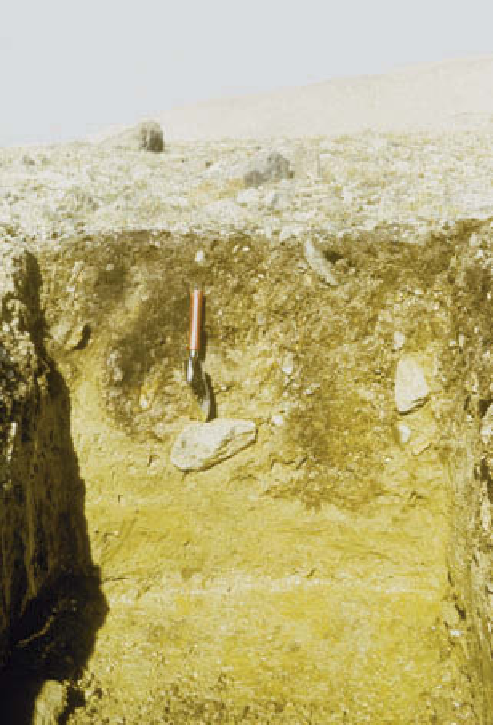Geoscience Reference
In-Depth Information
gleying on flat ground, but soils on slopes are drier, as
most rainwater runs off the surface or through upper
horizons to lower ground. Gleying reappears in valleys and
basins where run-off and through-flow concentrate. The
distribution of soils is shown in
Figure 18.4a
. In permeable
materials water penetrates to the subsoil, leaving higher
ground well drained. On lower land soils are affected by
ground water, as shown in
Figure 18.4b
.
The length of time a soil remains undisturbed by
erosion or deposition is important in its evolution. The
glaciations of the Pleistocene era removed the old soils
from much of Britain and other countries of mid to high
latitudes and deposited thick drift in other regions. Soil
formation began again on new surfaces after the final
retreat of the ice some 10,000 years ago. Old soils are more
common in low latitudes where the soil cover was not
eroded or buried during the Pleistocene.
Human activities have many effects on soils. Indirectly,
the native vegetation can be modified or removed.
Directly, soils are changed by agricultural practices. For
example, pollen analysis (
palynology
) of upland Britain
shows that the clearance of the upland deciduous
woodland by Mesolithic and Neolithic peoples led
eventually to the development of heathland and pozol
soils (see
Chapter 23).
Deforestation disrupted the
nutrient cycles of the brown earths under deciduous trees
and led to the acidification of soils and the invasion of
heather. This caused acid humus and thin peat on wetter
sites, leading to podzolization. Soils used for arable
agriculture have their relationships to soil-forming factors
changed by ploughing, draining and the use of lime and
fertilizers.
The five factors of soil formation do not operate as
single independent factors, of course. Climate influences
vegetation and human activities and is itself affected
by altitude and topography.
Figure 18.5
shows the
relationship of climate, altitude, slope and soils in the
uplands of the Pennines, Lake District, North York Moors
and Cheviots of northern England (Jarvis
et al.
1984).
Precipitation increases with altitude, giving intense
leaching and podzolization on well drained sites, chiefly
steep slopes. Waterlogging occurs on level high ground
owing to high rainfall, low evaporation and low tran-
spiration. Organic matter therefore accumulates as peat
on summits, or as podzols with peaty surface horizons
(stagno-podzols and stagno-humic gleys). On lower
ground, with lower rainfall and higher temperatures,
leaching is weaker, weathering is richer and brown earths
form. Podzols are here restricted to coarse-textured base-
deficient parent materials.
Devon Island, Canadian Arctic, with the top of permafrost at
75 cm depth at the bottom of the soil pit. Frost action
(cryoturbation) in the active layer moves black tongues of
organic matter into the subsoil.
Photo: Ken Atkinson
products. On drift deposits, poorly drained soils will form
in fine-textured clays and silts. However, well drained
brown earths (
cambisols
) occur where the deposits are
more permeable. Hard igneous, metamorphic and
sedimentary rocks disintegrate only slowly to give shallow,
stony, coarse-textured soils. Soft rocks give deep, less stony,
loamy soils. Where rocks are base-deficient it is common
to have acid or podzolized soils. The clay mineralogy
affects the potential for shrinking and swelling and the
composition of the cation exchange complex.
Relief and the slope profile influence hydrology and
soil water regime. On undulating ground with slowly
permeable parent materials, surface waterlogging causes










































